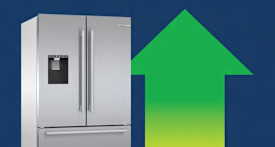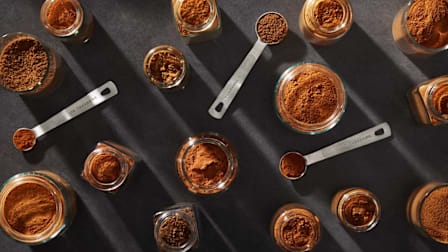Heavy Metals in Baby Food: What You Need to Know
Consumer Reports’ testing shows concerning levels of arsenic, cadmium, and lead in many popular baby and toddler foods

You’ve probably heard that lead has been found in drinking water, that certain kinds of fish contain high levels of mercury, and that worrisome amounts of arsenic have been found in rice. But you may not know why that’s a problem—or that these elements (and others, such as lead and cadmium), commonly known as “heavy metals,” are also in many other foods. This includes foods made just for babies and toddlers, such as popular snacks, cereals, prepared entrées, and packaged fruits and vegetables.
Over time, exposure to heavy metals can harm the health of adults and children. One of the biggest worries: cognitive development in very young children.
“Babies and toddlers are particularly vulnerable due to their smaller size and developing brains and organ systems,” says James E. Rogers, Ph.D., director of food safety research and testing at Consumer Reports. “They also absorb more of the heavy metals that get into their bodies than adults do.”
That’s why CR’s food safety team analyzed 50 nationally distributed packaged foods made for babies and toddlers, checking for cadmium, lead, mercury, and inorganic arsenic, the type most harmful to health.
Are There Still Heavy Metals in Baby Food?
Snacks and foods made with rice and sweet potatoes continue to have concerning levels of arsenic, cadmium, and lead, according to CR’s new tests.
Read about the findings of a Congressional report on heavy metals in baby food. CR says caregivers should not panic given the wide range of baby food options.
How Heavy Metals Can Harm Children
The human body needs small amounts of certain heavy metals, such as iron and zinc, to function properly. But cadmium, inorganic arsenic, lead, and mercury (especially methylmercury) can be toxic for everyone and pose particular risks for young children.
Exposure to even small amounts of these heavy metals at an early age may increase the risk of several health problems, especially lower IQ and behavior problems, and have been linked to autism and attention deficit hyperactivity disorder.
“The effects of early exposure to heavy metals can have long-lasting impacts that may be impossible to reverse,” says Victor Villarreal, Ph.D., an assistant professor in the department of educational psychology at the University of Texas at San Antonio who has researched the effects of heavy metals on childhood development.
For example, researchers at Duke University looked at 565 adults who had their lead levels measured as children. Those with high childhood lead readings had IQ levels 4.25 points lower, on average, than those with lower childhood lead levels.
Exposure to inorganic arsenic may also affect IQ, according to a recent Columbia University study of third- through fifth-graders in Maine. Students who had been exposed to arsenic in drinking water had IQ levels 5 to 6 points lower, on average, than students who had not been exposed.
Special Report: Lead and Cadmium Could Be in Your Dark Chocolate
CR found dangerous heavy metals in chocolate from Hershey’s, Theo, Trader Joe’s, and other popular brands.
Long-Term Risks
The risks from heavy metals grow over time, in part because they accumulate in the kidneys and other internal organs.
“These toxins can remain in your body for years,” says Tunde Akinleye, a chemist in Consumer Reports’ Food Safety Division who led our testing. Regularly consuming even small amounts over a long period of time may raise the risk of bladder, lung, and skin cancer; cognitive and reproductive problems; and type 2 diabetes, among other conditions.
And research has shown that even in adults, frequent, consistent exposure to low levels of heavy metals can contribute to other serious health problems.
A recent study in the journal Lancet Public Health suggests that low levels of lead from food and other sources contribute to about 400,000 deaths each year, more than half of them from cardiovascular disease. Getting too much methylmercury can cause nerve damage, muscle weakness, lack of coordination, and impaired vision and hearing. And over time, cadmium exposure can lead to kidney, bone, and lung diseases.

james worrell james worrell
What CR’s Tests Found
Previous Consumer Reports work found worrisome levels of heavy metals in canned tuna, protein powders, fruit juice, and rice and rice products, including infant rice cereals. Other nonprofit food safety organizations and the Food and Drug Administration have also found heavy metals in some of those foods. But this is the first time CR has looked at the levels of heavy metals in an array of baby and toddler foods, or determined the consumption levels that pose a risk to children. (For more information, download a PDF of CR's test protocol for heavy metals in baby and toddler foods.)
We looked at 50 popular baby and toddler foods, then purchased three samples of each from retailers across the country. (Our findings were a spot check of the market and should not be used to draw definitive conclusions about specific brands.)
The products fall into four categories:
• Baby cereals.
• Packaged fruits and vegetables.
• Packaged entrées (for example, turkey and rice dinner).
• Packaged snacks, including cookies, crackers, crunches, puffs, snack bars, wafers, and biscuits such as teething biscuits and rice rusks.
Most of the products came from the two biggest U.S. baby food manufacturers, Beech-Nut and Gerber. Other brands were Baby Mum-Mum, Earth’s Best, Ella’s Kitchen, Happy Baby, Parent’s Choice (Walmart), Plum Organics, and Sprout.
About two-thirds of the products (34) we tested contained concerning levels of cadmium, lead, and/or inorganic arsenic; 15 of them would pose a risk to a child who ate one serving or less per day.
Two rice cereals contained measurable levels of methylmercury. Although the amounts were not high enough to be associated with potential health risks from this heavy metal in our analysis, other research suggests that rice cereals may be an overlooked source of mercury in infants’ diets. For example, in tests of 119 infant cereals, researchers at Florida International University found that rice cereals had on average three times as much methylmercury as multigrain cereals and 19 times as much as other non-rice cereals.
Products made with rice fared the worst in our tests. That's because they contained worrisome amounts of inorganic arsenic, and many also had lead and cadmium.
As a category, snack foods—bars, cookies, crackers, crunches, crisps, puffs, and rice rusks and other teething biscuits—were most problematic, generally because of their rice content. That’s especially concerning because snacks are also the most common type of packaged product that babies and toddlers eat, according to CR’s recent survey. Seventy-two percent of parents said they feed their child at least one of the types of snack foods we tested.
CR’s findings that heavy metals are very common in rice products and that baby food cereals and snacks are higher in heavy metals than baby food fruit and vegetables are consistent with results from the Total Diet Study, an FDA program that monitors Americans’ intake of heavy metals and other contaminants from foods and beverages.
A Largely Unregulated Market
Our survey also suggests that parents are often unaware of the potential risks of heavy metals in their kids’ food. About half, for example, believed that children’s foods are subject to more strict regulation and safety testing procedures than other packaged foods.
But they aren’t—even though the FDA has acknowledged the dangers heavy metals in baby and toddler foods could pose.
In 2016, the FDA did propose limiting inorganic arsenic in infant rice cereal to 100 parts per billion, and in 2013 proposed limiting inorganic arsenic in apple juice to 10 ppb, the federal arsenic standard for drinking water. But neither limit was ever finalized. The agency told CR it is on track to finalize these guidelines by the end of 2018.
We informed the FDA of our overall findings, and the agency told us: “The agency has made this a priority and is working to reduce the health risks these elements present, especially to those most vulnerable: children.”
The agency also said it “plans to consider a wide range of policies and actions to reduce exposure,” such as educating consumers on how to reduce the risks posed by toxic metals and requiring or encouraging industry to lower the amount of them in their products. In addition, it is looking into the risk posed by foods that contain multiple toxic metals, and working to identify products “for which these combinations are most prevalent, and exploring options for dealing with the issue.”
What Manufacturers Say
We contacted all of the baby food manufacturers included in our testing. All stressed the importance of safety, and some noted that heavy metals can be naturally occurring. Most also said they did their own testing, and supported the government setting limits for heavy metals in baby and toddler foods.
“We are a responsible company with high safety standards for our ingredients and our products,” read one typical response, from Sprout. “We are continuing to work with the fruit and vegetable industry to look for the cleanest sources of ingredients. We fully support the evolution of FDA safety regulations that help ensure the highest levels of food safety standards for babies.”
Assessing the Risks
Just how dangerous is it for babies and toddlers to eat these foods? And what if you’ve been feeding your child one or more of these products every day for the past year or two or three?
To answer these questions, we looked into the potential health risks, based on several factors.
First, we estimated how much of these foods children typically eat, using data from the Centers for Disease Control and Prevention’s National Health and Nutrition Examination Survey.
We then reviewed the medical research to determine at what exposure level each heavy metal could increase the risk of certain cancers, kidney damage, reproductive disorders, and neurobehavioral problems.
Last, we put that information together with our own test results (along with the average body weights for each age group) and calculated how much a child would need to eat of the tested foods to face potential health risks.
“No amount of heavy metals such as lead can be considered safe,” says CR’s Rogers, “but less is certainly better.”
In many of the foods we tested, the levels of heavy metals combined were more concerning than the level of any one specific heavy metal. “Each of these metals has shown similar adverse effects on children’s developing brains and nervous systems, and there are potential additive effects,” says CR’s Akinleye.
Another concern: The amounts of heavy metals in any one type of food may be low, but because heavy metals are so pervasive in foods and the environment—and because they tend to accumulate in the body—small amounts can add up.
You’ll find a list of products we tested and the daily limit—the number of servings that pose a potential health risk—for each in the chart below.
If you have been giving these foods to your child, CR’s Dickerson says that it is important to have perspective. “The heavy metal content in baby and toddler foods is a concerning issue but not an imminent threat,” he says. “The risk comes from exposure over time, and the risk can be mitigated. Making changes to your child’s diet now can reduce the chance of negative outcomes in the future.”
There are many variables—genetics, type of exposure, and the overall quality of a child’s diet, for example—that affect how an individual responds to heavy metals in his or her environment or diet.
“You really don’t know if an individual child is going to be adversely affected,” says pediatrician Jennifer Lowry, M.D., chair of the American Academy of Pediatrics’ Council on Environmental Health. “This is not going to be a situation where we’ll find an acute, alarming level of these metals in the blood, as with ingesting lead from paint.” She says she typically would advise concerned parents to give their kids a variety of foods, and to remove the more concerning items from their diets.
And for some of the products CR tested, despite the presence of heavy metals, you’d have to feed your child quite a bit of the food for it to pose a risk. For instance, our analysis found that it would take more than five servings of Plum Organics’ Little Yums Organic Teething Wafers per day before his or her intake from that product alone reached a level of concern.
A Loss for Public Safety
While there is a lack of federal regulations for the amount of heavy metals in most foods, California does set a threshold for lead. Products sold in the state that can expose someone to more than 0.5 microgram of lead per day must have a health warning, according to California’s Safe Drinking Water and Toxic Enforcement Act (often referred to as Proposition 65).
Based on our test results, all the samples of Beech-Nut Classics Sweet Potatoes, Earth’s Best Organic Sweet Potatoes, and Gerber Turkey & Rice had concerning levels of lead. We purchased one sample of each of those products in California, and we believe our samples exceeded the state’s threshold.
We sent our findings to Beech-Nut, Gerber, and Hain Celestial, the parent company of Earth’s Best.
Gerber and Hain Celestial said that they believed their products complied with the California law. But Gerber also said it went back and tested samples of its turkey and rice dinner from the same three batches CR tested. The company said it got similar results and that it was “reviewing our protocols for further improvement.”
Beech-Nut said that it had "reviewed the ingredient testing reports of its independent lab, which showed the lead levels as undetectable," but that as a result of an internal investigation, the company “upgraded the requirements for our third-party lab testing."
Hain Celestial also pointed to a 2015 case involving the nonprofit Environmental Law Foundation. The organization had sued Beech-Nut and other companies after it claimed that its testing found that some of the companies’ fruit juices and other fruit products sold in California exceeded 0.5 mcg of lead in one serving, and therefore should require a warning.
However, the defense lawyers successfully argued that the daily limit could be averaged over a two-week period, based on typical consumption levels. This means, for example, that a person could consume up to 13 servings of a product with 0.5 mcg per serving in 14 days without exceeding the daily threshold.
CR’s food safety experts are troubled by this ruling. “We believe the outcome of this case significantly undermines public health, especially when it comes to protecting children,” says CR’s Dickerson. “The amount of lead permitted under this ruling is not a level we consider safe, given what we know about consumption of these baby foods.”
Jay Schneider, Ph.D., a professor of anatomy, pathology, and cell biology at Thomas Jefferson University in Philadelphia, has examined hundreds of children who have suffered the effects of lead exposure. Given lead’s extreme toxicity, and the inability to reverse or remediate its effects, he calls it “outrageous” that there would even be the tiniest amount of lead in children’s food.
“It’s extremely potent,” says Schneider. “We know that there is no level of lead in the blood of a child that is safe.”
How Heavy Metals Get Into Food
Where are these heavy metals coming from, and why are they in food?
They all are part of the earth’s crust, so they are naturally found in the environment. But most of the heavy metals in food come from soil or water that has been contaminated through either farming and manufacturing practices (such as pesticide application, mining, and smelting) or pollution (such as the use of leaded gasoline).
Crops absorb heavy metals from earth and water, the same way they do nutrients. But some crops take up more of the compounds than others. For example, rice absorbs about 10 times more arsenic than other grains absorb.
In packaged foods, it is also possible that something in the manufacturing process, such as the type of metal used in machinery, contributes to contamination.
It's also important to know that these heavy metals aren't just in packaged baby and toddler foods. “Rice, for instance, is known to contain inorganic arsenic whether it is part of an infant cereal, a rice pilaf mix, or a rice cracker,” Akinleye says. So, depending on the food type and source, making your own baby food won't necessarily reduce your child’s heavy metal intake.
Still, some research suggests that children’s food may have more of certain heavy metals than other foods. For example, according to the Environmental Defense Fund’s recent analysis of the FDA’s Total Diet Study data, more samples of baby food apple juice, grape juice, and carrots had detectable levels of lead than regular versions of those foods. Why that would be the case is unclear, though it is possible that there are differences in the manufacturing processes.
Organic Isn’t Safer
Although foods that are certified as organic by the USDA do have benefits—including lower pesticide levels and less impact on the environment—avoiding heavy metals isn’t one of them. Twenty of the products in our test were labeled organic, and, as a whole, they were just as likely to contain heavy metals as the conventional ones.
“Arsenic and lead, which have been used in the past as pesticides, are prohibited under organic regulations,” says Charlotte Vallaeys, Consumer Reports’ food labeling expert. But because these heavy metals are contaminants in the soil, there's no reason why organic baby foods would contain lesser amounts.”
That may surprise many parents, though. In our survey, 39 percent of parents who purchased packaged foods sometimes bought organic food for their children, and they cited avoiding lead, arsenic, and other heavy metals as their primary reason for doing it.

iStock-184093369 iStock-184093369
What Needs to Change
Parents want tough standards for the foods they feed their children: 72 percent of those in our recent survey said that baby foods should be subject to more stringent regulation and safety testing than other foods.
And CR’s recent tests suggest that the FDA needs to set regulatory limits for heavy metals in baby foods. Read the letter CR sent to the FDA about our findings (PDF).
“Any limits would be welcome, but the ultimate goal is to have no measurable levels of any heavy metal in baby and toddler foods,” says Jean Halloran, director of food policy initiatives at Consumers Union, the advocacy division of Consumer Reports.
Our test results also showed that goal is achievable.
“In about a third of the products we tested, the amounts of heavy metals were below our level of concern, and for some of the products, amounts of some metals were not measurable,” Rogers says. “Every category of food we tested was represented in that lower-risk group. That indicates that there are ways for manufacturers to significantly reduce or eliminate these metals from their products.”
To that end, Halloran says that the FDA should take the following actions, quickly:
Establish aggressive targets. Set a goal of having no measurable amounts of cadmium, lead, or inorganic arsenic in baby and children's food—and use the most sensitive testing methods to determine the presence of those metals.
Create and enforce benchmarks. To reach its goals in baby and children’s food, the FDA should set incremental targets for industry to meet along the way.
Meanwhile, finalize proposed guidelines. By the end of 2018 (the FDA’s planned deadline), the agency should limit inorganic arsenic in apple juice to 10 ppb, the arsenic standard for bottled water, and limit inorganic arsenic in infant rice cereal to 100 ppb. In addition, it should revise existing guidance for lead in fruit juice to reduce the limit from 50 to 5 ppb, the standard for bottled water.
(Sign CR's petition to tell the FDA to take action to keep infants and children safe.)
What Manufacturers Should Do
Children’s food manufacturers don’t have to wait for the FDA before they reduce the heavy metal content of their products.
What Parents Can Do
CR’s Dickerson says parents should remember that exposure to heavy metals doesn’t guarantee that a child will face health problems as a result, only that it increases that chance. If you are concerned about possible exposure, talk with your pediatrician about having your child tested.
It may not be possible to completely eliminate heavy metals from your food. But there are steps you can take to reduce the amount of heavy metals you and your children are exposed to, and to minimize some of the effects of heavy metals. “Just making changes now will go a long way to protecting your children, regardless of any prior exposure,” Dickerson says. These tips will help:
Limit the amount of infant rice cereal your child eats. Cereal is often a baby’s first solid food because it is easy to swallow, and it’s usually fortified with iron, an important nutrient for babies. But both the FDA and the American Academy of Pediatrics say that there’s no reason it must be rice cereal and that infants should be given a variety of cereals, noting concerns about levels of inorganic arsenic in those products. “Parents have other choices—there are iron-fortified cereals made from other whole grains, such as oats, that are lower in inorganic arsenic,” Rogers says.
Choose the right rice. In previous CR tests, brown rice had more inorganic arsenic than white rice of the same type. White basmati rice from California, India, and Pakistan, and sushi rice from the U.S., are good choices that had, on average, half as much inorganic arsenic as most other types. Rice cakes, cereal, and pasta were also high in inorganic arsenic.
Rethink rice prep. Cook it in a large amount of water—the FDA recommends 6 to 10 parts water to 1 part rice—and drain it well afterward. This will help reduce arsenic content.
Limit packaged snacks. Many contain rice flour, but even those without it don’t supply much nutritional value. “Even without the heavy metal risks, snack items aren’t a necessary part of your child’s diet, and they can have added sugars and sodium,” says Amy Keating, R.D., a nutritionist at Consumer Reports. The same goes for rice cakes, rice crackers, and chips that you and your child may eat.
Seek out whole foods low in heavy metals. Based on their review of the data from the Total Diet Study, our experts suggested a few easy-to-pack foods, suitable for snacking, that are very low in heavy metals: apples, applesauce (unsweetened), avocados, bananas, barley with diced vegetables, beans, cheese, grapes, hard-boiled eggs, peaches, strawberries, and yogurt.
Be wary of fruit juice. Past CR tests found inorganic arsenic and lead in many brands of apple and grape juices. In addition, all fruit juices are concentrated sources of sugars, and lack fiber. The American Academy of Pediatrics recommends not giving any fruit juice to babies in the first year of life, and limiting juice to 4 ounces a day for kids ages 1 to 3 years and 6 ounces for 4- to 6-year-olds, for nutritional reasons.
Go easy on the chocolate. Cocoa powder may contain cadmium and/or lead. Cocoa itself may have more than dark chocolate, and dark chocolate may have more than milk chocolate.
Pick the right fish. Bigeye tuna, king mackerel, orange roughy, shark, and swordfish are particularly high in methylmercury. Children and women of childbearing age should avoid these fish; others should eat them infrequently, if at all.
Take a pass on protein powders. These may contain arsenic, cadmium, and lead, according to tests from CR and others. Whey and egg-based powders tended to have less than plant-based ones—such as soy and hemp—but even they should be used in moderation. You probably don’t need them anyway. “The vast majority of people get plenty of protein from the foods they eat,” says Keating. “And when you get your protein from foods, you also benefit from all the other nutrients found in whole foods.”
Check your water. If you get your water from a well, or if your home has older pipes, consider having your water tested. Heavy metals sometimes seep into well water, and older pipes may have been made with lead.
Eat a broad array of healthful whole foods. Rotating the foods you eat may help you avoid overconsumption of heavy metals and provide a variety of nutrients that may help offset some of the damage heavy metals do to the body. These include calcium, iron, selenium, vitamin C, and zinc.
Where We Found Heavy Metals
Consumer Reports tested the 50 baby and toddler foods listed in the chart below. These products represent a cross section of the market. We tested three samples of each food, and the samples were purchased from different retailers across the country. In the chart, these products are organized into four main categories: cereals, snacks (such as bars, biscuits, and rice rusks), packaged fruits and vegetables, and entrées.
While our findings are a spot check of the market and cannot be used to draw definitive conclusions about specific brands, every product we tested had measurable levels of at least one of these toxic heavy metals: cadmium, inorganic arsenic, and/or lead; 34 of the products contained enough of a single heavy metal or a combination to reach a level that CR’s food safety experts believe warrants concern.
For each food, we have calculated a daily limit—the number of servings a child would need to eat for the food to pose potential health risks from exposure to the three heavy metals. The top section of each category lists foods that, based on CR’s analyses, pose less concern; there is no daily limit for these. The bottom section of each category shows foods of more concern, listed in order of the number of servings that would present potential health risks to a child. The lower the daily limit, the greater the risk from that food.
Unless otherwise noted, CR’s shoppers were able to still find these products on the market in the spring of 2018. Though in some cases the manufacturer told CR that the product has a new label or packaging, or has been reformulated, our shoppers were able to find the product as we tested it in stores or online.
Meals and Entrées
Gerber Lil' Entrées Chicken & Brown Rice With Peas & Corn
Serving size: 1 tray
No Daily Limit
Earth's Best Organic Chicken & Brown Rice
Serving size: 4-oz. jar
Daily Limit: <1 Serving
Earth's Best Turkey, Red Beans & Brown Rice
Serving size: 1 pouch
Daily Limit: <1 Serving
Gerber Chicken & Rice
Serving size: 4-oz. jar
Daily Limit: <1 Serving
Gerber Turkey & Rice
Serving size: 4-oz. jar
Daily Limit: <1 Serving
Sprout Organic Baby Food Garden Vegetables Brown Rice With Turkey
Serving size: 1 pouch
Daily Limit: <1 Serving
Gerber Lil' Meals White Turkey Stew With Rice & Vegetables1
Serving size: 1 tray
Daily Limit: <0.5 Serving
Fruits and Vegetables
Beech-Nut Classics Apple, Pear & Banana
Serving size: 4-oz. jar
No Daily Limit
Beech-Nut Naturals Carrot, Broccoli, Apple & Strawberry1
Serving size: 4-oz. jar
No Daily Limit
Beech-Nut Organic Just Apple & Green Beans
Serving size: 4-oz. jar
No Daily Limit
Beech-Nut Organic Peas, Green Beans, and Avocado
Serving size: 1 pouch
No Daily Limit
Gerber Grabbers Strong Veggies, Broccoli, Carrot, Banana, Pineapple
Serving size: 1 pouch
No Daily Limit
Gerber Organic Peas, Carrots & Beets1
Serving size: 1 pouch
No Daily Limit
Happy Baby Organics Purple Carrots, Bananas, Avocados & Quinoa
Serving size: 1 pouch
No Daily Limit
Gerber Carrot, Pear & Blackberry
Serving size: 4-oz. container
Daily Limit: <1 Serving
Gerber Carrots Peas & Corn With Lil' Bits1
Serving size: 5-oz. container
Daily Limit: <1 Serving
Plum Organics Just Sweet Potato Organic Baby Food
Serving size: 1 pouch
Daily Limit: <1 Serving
Beech-Nut Classics Sweet Potatoes
Serving size: 4-oz. jar
Daily Limit: <0.5 Serving
Earth's Best Organic Sweet Potatoes, 1st Stage
Serving size: 2.5-oz. jar
Daily Limit: <0.5 Serving
Cereals
Gerber Breakfast Buddies Hot Cereal With Real Fruit, Apple Cinnamon1
Serving size: 1 bowl
No Daily Limit
Beech-Nut Complete Rice Single Grain Baby Cereal
Serving size: 0.5 cup
Daily Limit: <3 Servings
Happy Baby Organics Organic Probiotic Baby Cereal
Serving size: 4 tablespoons
Daily Limit: <3 Servings
Beech-Nut Complete Oatmeal Whole Grain Baby Cereal
Serving size: 0.5 cup
Daily Limit: <2.5 Servings
Beech-Nut Organic Oatmeal Whole Grain Baby Cereal
Serving size: 0.5 cup
Daily Limit: <2.5 Servings
Earth's Best Organic Whole Grain Oatmeal Cereal
Serving size: 4 tablespoons
Daily Limit: <2.5 Servings
Gerber Oatmeal Single Grain Cereal
Serving size: 0.5 cup
Daily Limit: <2.5 Servings
Gerber Organic Oatmeal Cereal
Serving size: 0.5 cup
Daily Limit: <2.5 Servings
Earth's Best Organic Whole Grain Rice Cereal
Serving size: 4 tablespoons
Daily Limit: <1 Serving
Snack Foods
Beech-Nut Quinoa Crispies, Vanilla
Serving size: 1 bar
No Daily Limit
Ella's Kitchen Apples + Strawberries Nibbly Fingers
Serving size: 0.33 bar
No Daily Limit
Gerber Graduates Puffs Cereal Snack, Strawberry Apple
Serving size: 0.5 cup
No Daily Limit
Gerber Lil' Beanies Baked Snack Made With Beans, White Cheddar & Broccoli1
Serving size: 26 pieces
No Daily Limit
Gerber Lil' Crunchies Baked Corn Snack Mild Cheddar
Serving size: 16 pieces
No Daily Limit
Gerber Lil' Crunchies Baked Corn Snack Vanilla Maple
Serving size: 16 pieces
No Daily Limit
Gerber Organic Puffs, Puffed Grain Snack, Apple
Serving size: 0.5 cup
No Daily Limit
Gerber Graduates Arrowroot Cookies
Serving size: 1 cookie
Daily Limit: <6 Servings
Plum Organics Little Yums Organic Teething Wafers, Pumpkin & Banana1
Serving size: 1 Wafer
Daily Limit: <5.5 Servings
Gerber Graduates Cinnamon Graham Animal Crackers
Serving size: 2 crackers
Daily Limit: <4.5 Servings
Gerber Graduates Banana Cookies
Serving size: 1 cookie
Daily Limit: <4 Servings
Baby Mum-Mum Banana Rice Rusks
Serving size: 4 rusks
Daily Limit: <3 Servings
Baby Mum-Mum Vegetable Rice Rusks
Serving size: 4 rusks
Daily Limit: <3 Servings
Gerber Graduates Waffle Wheels Puffed Grain Snack, Banana Cream
Serving size: 4 pieces
Daily Limit: <3 Servings
Gerber Graduates Lil' Biscuits Vanilla Wheat
Serving size: 1 biscuit
Daily Limit: <2.5 Servings
Gerber Graduates Cereal Bars, Strawberry Banana
Serving size: 1 bar
Daily Limit: <1.5 Servings
Parent's Choice (Walmart) Little Puffs Cereal Snack, Strawberry Apple
Serving size: 0.5 cup
Daily Limit: <1.5 Servings
Plum Organics Mighty Sticks Whole Grain Snacks, Berry Beet1
Serving size: 1 pack
Daily Limit: <1.5 Servings
Sprout Organic Quinoa Puffs Baby Cereal Snack, Apple Kale
Serving size: 0.33 cup
Daily Limit: <1.5 Servings
Earth's Best Organic Sunny Days Snack Bars, Strawberry
Serving size: 1 bar
Daily Limit: <1 Serving
Happy Baby Organics Superfood Puffs, Apple & Broccoli
Serving size: 0.5 cup
Daily Limit: <1 Serving
Happy Baby Organics Superfood Puffs, Purple Carrot & Blueberry
Serving size: 0.5 cup
Daily Limit: <1 Serving




















